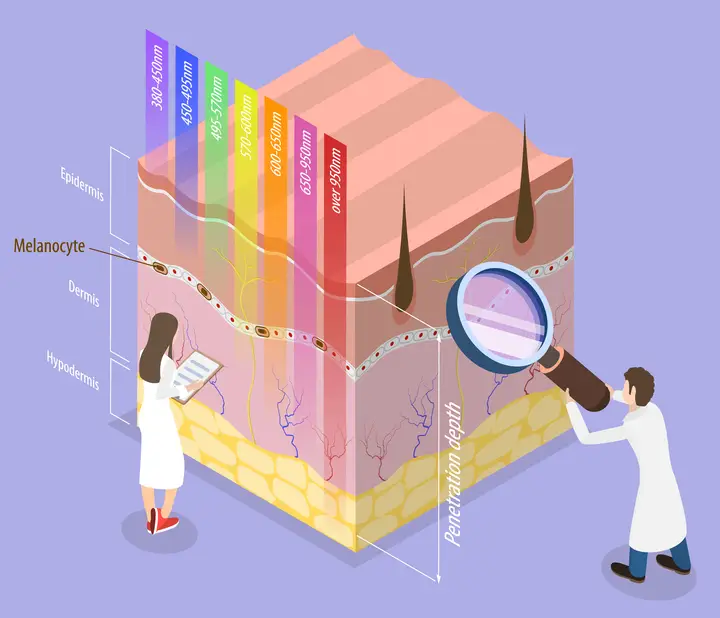Activate the Healing Power Within
Near-Infrared Therapy (NIRt) has garnered attention for its potential to activate anti-inflammatory processes. Near-infrared light is part of the infrared light spectrum and is the closest to the visible range. Studies suggest that near-infrared light can increase the activity of cytochrome oxidase and superoxide dismutase. Which in turn means its role in inducing beneficial metabolic and antioxidant effects.
Furthermore, research on NIR light suggests that it enhances human cerebral blood flow and cognitive functions without adverse effects. NIRt is a novel paradigm for the recommended treatment of visual and neurological conditions. It provides scientific evidence to support the use of NIRt, emphasizing molecular and cellular mechanisms in various situations. While not fully understood, the mechanisms underlying the therapeutic benefits of NIRt appear to depend upon the absorption of NIR photons in the wavelength range of 600–1,200 nm by cytochrome c oxidase in the mitochondria.
ARRC LED utilizes near-infrared wavelengths as carrier waves for frequency augmentation. The depth gained from NIR penetration into the body creates an extraordinary vehicle to modulate biological processes with a resonant frequency.
ARRC LED utilizes three distinct near-infrared wavelengths: 810 nm, 850 nm, and 940 nm. Our wavelength and frequency formulations are patent pending.
The History of NIRt
Photobiomodulation may sound new to many people and clinicians, but forms of light therapy have been known for over 50 years of independent research worldwide. NASA began researching light treatment in the 1990s, and universities and research institutions worldwide have since studied it for its suggested beneficial effects on diabetes, neuropathy, wound healing, and other conditions.[1] Scientists from NASA have found that cells exposed to near-infrared light from LEDs, the energy just outside the visible range, may grow 150 to 200 percent faster than cells not stimulated by such light. In theory, they found that the light arrays can increase power (ATP and nitric oxide) and speed up the healing process.
The Benefits of NIRt
The critical characteristic of near-infrared light is its suggested ability to penetrate deep layers of the skin, the body’s muscles, and other tissues, and even down to the bone. In theory, NIRt can provide faster healing and better pain relief.
This deep tissue penetration occurs because near-infrared wavelengths encounter less interference from blood, water, and other biological structures that typically absorb or scatter visible light. Near-infrared energy can penetrate depths of several inches into the body, enabling it to influence cellular processes in muscles, joints, organs, and the bone marrow. This unique penetration capability allows near-infrared light to stimulate mitochondrial function and healing responses in areas that traditional surface treatments cannot effectively reach.
According to the research, Near-Infrared Light Therapy may have positive effects on the human body, such as:[2]
- Recharges mitochondria
- Promotes cell regeneration
- Increases energy
- Reduces inflammation
- Improves circulation
- Heals wounds faster
- Faster recovery time after working out
- Provides pain relief
- Rejuvenates the skin
- Lessen joint and muscle pain
- Improves flexibility
- Provides anti-aging benefits
The Research Supporting NIR Therapy
Near-infrared light therapy targets cytochrome c oxidase in cellular mitochondria, resulting in increased ATP production and enhanced cellular energy metabolism. This photobiomodulation process triggers a host of beneficial effects, including enhanced cell survival, increased proliferation, and new protein synthesis that supports overall tissue health.[3] The therapy exhibits a distinctive capacity to mitigate oxidative stress in diseased or damaged cells while simultaneously augmenting antioxidant defenses throughout the body. Research consistently shows that near-infrared light produces significant reductions in inflammation across multiple body systems, including joints, brain tissue, lungs, and wound sites, making it particularly valuable for treating inflammatory conditions and traumatic injuries.
Longevity and Age-Related Benefits
Studies demonstrate that near-infrared light therapy can significantly impact aging processes by improving mitochondrial function and reducing age-related cellular decline.[4] Research with aging animals has shown that daily exposure to 670 nm near-infrared light increases ATP production in retinal tissues while reducing inflammation markers associated with aging. Perhaps most remarkably, this treatment resulted in dramatic lifespan extensions, with 100 to 175 percent more subjects surviving into old age compared to untreated groups. These longevity benefits were accompanied by improved mobility and function, suggesting that near-infrared light therapy may offer a simple yet powerful approach to extending a healthy lifespan and maintaining vitality as we age.
Are There Side Effects of NIR Light Therapy?
Near-infrared light therapy demonstrates exceptional safety with minimal side effects when used according to proper protocols, making it one of the most well-tolerated wellness treatments available. Healthcare professionals and researchers consistently report that NIR light therapy produces beneficial effects through non-invasive photobiomodulation without the risks associated with ultraviolet wavelengths or high-powered laser treatments.
Clinical trials and systematic reviews confirm that specific wavelengths used in near-infrared therapy safely stimulate mitochondria and cytochrome c oxidase without causing tissue damage. The FDA has cleared numerous red light therapy devices for at-home use, further validating the safety profile of this photobiomodulation therapy for pain relief, wound healing, and anti-aging applications.
Eye protection remains the primary safety consideration during near-infrared light treatment, as direct exposure to concentrated light sources can potentially damage retinal tissues. Quality near-infrared light therapy devices include protective goggles to shield eyes from photon exposure during full-body or targeted treatment sessions. While side effects are rare, some individuals may experience temporary mild skin redness or slight fatigue as cellular energy production increases through enhanced ATP synthesis.
These minimal reactions typically indicate that effective photobiomodulation is occurring at the cellular level, stimulating beneficial processes such as collagen production, improved blood flow, and anti-inflammatory responses that contribute to the significant health benefits documented in controlled trials and dermatological research.
